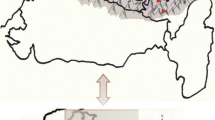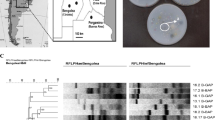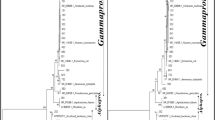Abstract
Less than 1 % of bacterial populations present in environmental samples are culturable, meaning that cultivation will lead to an underestimation of total cell counts and total diversity. However, it is less clear whether this is also true for specific well-defined groups of bacteria for which selective culture media is available. In this study, we use culture dependent and independent techniques to describe whether isolation of Pseudomonas spp. on selective nutrient-poor NAA 1:100 agar-medium can reflect the full diversity, found by pyrosequencing, of the total soil Pseudomonas community in an urban waste field trial experiment. Approximately 3,600 bacterial colonies were isolated using nutrient-poor NAA 1:100 medium from soils treated with different fertilizers; (i) high N-level sewage sludge (SA), (ii) high N-level cattle manure (CMA), and (iii) unfertilized control soil (U). Based on Pseudomonas specific quantitative-PCR and Pseudomonas CFU counts, less than 4 % of Pseudomonas spp. were culturable using NAA 1:100 medium. The Pseudomonas selectivity and specificity of the culture medium were evaluated by 454 pyrosequencing of 16S rRNA gene amplicons generated using Bacteria- and Pseudomonas-specific primers. Pyrosequencing results showed that most isolates were Pseudomonas and that the culturable fraction of Pseudomonas spp. reflects most clusters of the total Pseudomonas diversity in soil. This indicates that NAA 1:100 medium is highly selective for Pseudomonas species, and reveals the ability of NAA 1:100 medium to culture mostly the dominant Pseudomonas species in soil.



Similar content being viewed by others
References
Aagot N, Nybroe O, Nielsen P, Johnsen K (2001) An altered Pseudomonas diversity is recovered from soil by using nutrient-poor Pseudomonas-selective soil extract media. Appl Environ Microbiol 67:5233–5239
Amann RI, Ludwig W, Schleifer KH (1995) Phylogenetic identification and in situ detection of individual microbial cells without cultivation. Microbiol Rev 59:143–169
Bergmark L, Poulsen PHB, Al-Soud WA, Norman A, Hansen LH, Sørensen SJ (2012) Assessment of the specificity of Burkholderia and Pseudomonas qPCR assays for detection of these genera in soil using 454 pyrosequencing. FEMS Microbiol Lett 333:77–84
Bodilis J, Nsigue-Meilo S, Besaury L, Quillet L (2012) Variable copy number, intra-genomic heterogeneities and lateral transfers of the 16S rRNA gene in Pseudomonas. PLoS ONE 7:e35647
Caporaso JG, Bittinger K, Bushman FD, DeSantis TZ, Andersen GL, Knight R (2010) PyNAST: a flexible tool for aligning sequences to a template alignment. Bioinformatics 26:266–267
Caporaso JG, Kuczynski J, Stombaugh J, Bittinger K, Bushman FD, Costello EK, Fierer N, Pena AG, Goodrich JK, Gordon JI et al (2010) QIIME allows analysis of high-throughput community sequencing data. Nat Methods 7:335–336
Cole JR, Chai B, Farris RJ, Wang Q, Kulam SA, McGarrell DM, Garrity GM, Tiedje JM (2005) The Ribosomal Database Project (RDP-II): sequences and tools for high-throughput rRNA analysis. Nucleic Acids Res 33:D294–D296
Edgar RC (2010) Search and clustering orders of magnitude faster than BLAST. Bioinformatics 26:2460–2461
Evans FF, Seldin L, Sebastian GV, Kjelleberg S, Holmstrom C, Rosado AS (2004) Influence of petroleum contamination and biostimulation treatment on the diversity of Pseudomonas spp. in soil microcosms as evaluated by 16S rRNA based-PCR and DGGE. Lett Appl Microbiol 38:93–98
Fava F, Armenante PM, Kafkewitz D (1995) Aerobic degradation and dechlorination of 2-chlorophenol, 3-chlorophenol and 4-chlorophenol by a Pseudomonas pickettii strain. Lett Appl Microbiol 21:307–312
Goebel BM, Stackebrandt E (1994) Cultural and phylogenetic analysis of mixed microbial populations found in natural and commercial bioleaching environments. Appl Environ Microbiol 60:1614–1621
Gould WD, Hagedorn C, Bardinelli TR, Zablotowicz RM (1985) New selective media for enumeration and recovery of fluorescent pseudomonads from various habitats. Appl Environ Microbiol 49:28–32
Hill GA, Robinson CW (1975) Substrate inhibition kinetics—phenol degradation by Pseudomonas putida. Biotechnol Bioeng 17:1599–1615
Johnsen K, Nielsen P (1999) Diversity of Pseudomonas strains isolated with King’s B and Gould’s S1 agar determined by repetitive extragenic palindromic polymerase chain reaction, 16S rDNA sequencing and Fourier transform infrared spectroscopy characterisation. FEMS Microbiol Lett 173:155–162
Johnson JK, Arduino SM, Stine OC, Johnson JA, Harris AD (2007) Multilocus sequence typing compared to pulsed-field gel electrophoresis for molecular typing of Pseudomonas aeruginosa. J Clin Microbiol 45:3707–3712
Kim M, Morrison M, Yu ZT (2011) Evaluation of different partial 16S rRNA gene sequence regions for phylogenetic analysis of microbiomes. J Microbiol Methods 84:81–87
King EO, Ward MK, Raney DE (1954) Two simple media for the demonstration of pyocyanin and fluorescin. J Lab Clin Med 44:301–307
Klappenbach JA, Saxman PR, Cole JR, Schmidt TM (2001) rrndb: the Ribosomal RNA Operon Copy Number Database. Nucleic Acids Res 29:181–184
Kragelund L, Leopold K, Nybroe O (1996) Outer membrane protein heterogeneity within Pseudomonas fluorescens and P. putida and use of an OprF antibody as a probe for rRNA homology group I pseudomonads. Appl Environ Microbiol 62:480–485
Lloyd-Jones G, Laurie AD, Tizzard AC (2005) Quantification of the Pseudomonas population in New Zealand soils by fluorogenic PCR assay and culturing techniques. J Microbiol Methods 60:217–224
Lozupone C, Knight R (2005) UniFrac: a new phylogenetic method for comparing microbial communities. Appl Environ Microbiol 71:8228–8235
Magid J, Luxhøi J, Jensen LS, Møller J, Bruun S (2006) Establishment of a long-term field trial with urban fertilizers—is recycling of nutrients from urban areas to peri-urban organic farms feasible? In: Raupp J, Pekrun C, Oltmanns M, Köpke U (eds) Long-term field experiments in organic farming. Society of Organic Agriculture Research (ISOFAR). Verlag Dr. Köster, Berlin, pp 59–78
Masoud W, Takamiya M, Vogensen FK, Lillevang S, Abu Al-Soud W, Sorensen SJ, Jakobsen M (2011) Characterization of bacterial populations in Danish raw milk cheeses made with different starter cultures by denaturating gradient gel electrophoresis and pyrosequencing. Int Dairy J 21:142–148
Masuda N, Sakagawa E, Ohya S, Gotoh N, Tsujimoto H, Nishino T (2000) Substrate specificities of MexAB-OprM, MexCD-OprJ, and MexXY-OprM efflux pumps in Pseudomonas aeruginosa. Antimicrob Agents Chemother 44:3322–3327
Peix A, Ramirez-Bahena MH, Velazquez E (2009) Historical evolution and current status of the taxonomy of genus Pseudomonas. Infect Genet Evol 9:1132–1147
Poole K (2001) Multidrug efflux pumps and antimicrobial resistance in Pseudomonas aeruginosa and related organisms. J Mol Microbiol Biotechnol 3:255–264
Poulsen PHB, Al-Soud WA, Bergmark L, Magid J, Hansen LH, Sørensen SJ (2013) Effects of fertilization with urban and agricultural organic wastes in a field trial—Prokaryotic diversity investigated by pyrosequencing. Soil Biol Biochem 57:784–793
Quince C, Curtis TP, Sloan WT (2008) The rational exploration of microbial diversity. ISME J 2:997–1006
Roesch LF, Fulthorpe RR, Riva A, Casella G, Hadwin AKM, Kent AD, Daroub SH, Camargo FAO, Farmerie WG, Triplett EW (2007) Pyrosequencing enumerates and contrasts soil microbial diversity. ISME J 1:283–290
Ross IL, Alami Y, Harvey PR, Achouak W, Ryder MH (2000) Genetic diversity and biological control activity of novel species of closely related pseudomonads isolated from wheat field soils in South Australia. Appl Environ Microbiol 66:1609–1616
Sogin ML, Morrison HG, Huber JA, Welch DM, Huse SM, Neal PR, Arrieta JM, Herndl GJ (2006) Microbial diversity in the deep sea and the underexplored “rare biosphere”. Proc Natl Acad Sci USA 103:12115–12120
Spasenovski T, Carroll MP, Payne MS, Bruce KD (2009) Molecular analysis of diversity within the genus Pseudomonas in the lungs of cystic fibrosis patients. Diagn Microbiol Infect Dis 63:261–267
Stover CK, Pham XQ, Erwin AL, Mizoguchi SD, Warrener P, Hickey MJ, Brinkman FSL, Hufnagle WO, Kowalik DJ, Lagrou M et al (2000) Complete genome sequence of Pseudomonas aeruginosa PAO1, an opportunistic pathogen. Nature 406:959–964
Tarnawski S, Hamelin J, Locatelli L, Aragno M, Fromin N (2003) Examination of Gould’s modified S1 (mS1) selective medium and Angle’s non-selective medium for describing the diversity of Pseudomonas spp. in soil and root environments. FEMS Microbiol Ecol 45:97–104
Widmer F, Seidler RJ, Gillevet PM, Watrud LS, Di Giovanni GD (1998) A highly selective PCR protocol for detecting 16S rRNA genes of the genus Pseudomonas (sensu stricto) in environmental samples. Appl Environ Microbiol 64:2545–2553
Yao JDC, Moellering RC Jr (1999) Antibacterial agents. In: Murrary PR (ed) Manual of clinical microbiology, 7th edn. American Society for Microbiology, Washington DC, pp 1474–1504
Acknowledgments
We thank Annelise Kjøller for proofreading of the manuscript and technician Karin Vestberg for excellent help with laboratory work. The authors thank the Danish Research Centre for Organic Food and Farming (DARCOF), for supporting the project CRUCIAL (Closing the Rural Urban Nutrient Cycle), and the Center for Environmental and Agricultural Microbiology (CREAM), funded by The Villum Foundation.
Author information
Authors and Affiliations
Corresponding author
Additional information
Lili Li and Waleed Abu Al-Soud contributed equally to this study.
Rights and permissions
About this article
Cite this article
Li, L., Abu Al-Soud, W., Bergmark, L. et al. Investigating the Diversity of Pseudomonas spp. in Soil Using Culture Dependent and Independent Techniques. Curr Microbiol 67, 423–430 (2013). https://doi.org/10.1007/s00284-013-0382-x
Received:
Accepted:
Published:
Issue Date:
DOI: https://doi.org/10.1007/s00284-013-0382-x




